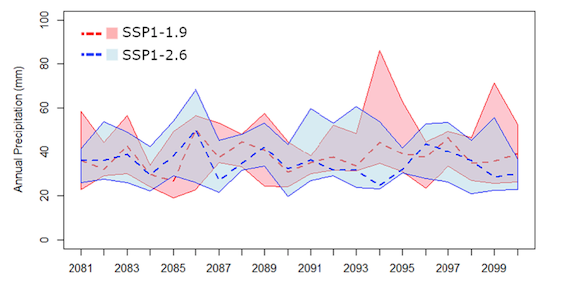A new study analyses the projected changes in precipitation and precipitation extremes in Egypt at the end of the century for 1.5 and 2.0°C warming. The article was published in Atmospheric Research by Mohamed S Nashwan (Arab Academy for Science, Technology and Maritime Transport, Egypt) and Shamsuddin Shahid (University of Malaysia).
Abstract
Rainfall projections for 1.5 and 2.0 °C warming can explain regional precipitation response to emission reductions under the Paris Agreements’ goals. Assessment of such changes is vital for Egypt, a global climate change hotspot. The performance of 29 CMIP6 GCMs’ hindcasts was evaluated according to their capability to replicate the spatial patterns of annual, winter, and summer precipitation for 1971–2014 to select a suitable GCM subset to form a robust multimodel ensemble (MME). The MME median was used to project precipitation and precipitation extremes of Egypt at the end of the century (2081–2100) for two shared socioeconomic pathways (SSP) scenarios, SSP1–1.9 and SSP1–2.6, representing 1.5 and 2.0 °C warming at the end of the present century, respectively. The results showed an increase in precipitation in the northern high precipitation region by 37% and 54% for SSP1–1.9 and SSP1–2.6, respectively, and a decrease in the southwestern low precipitation region by −35% for both scenarios. The projected increase would be mostly in winter and almost no change in summer. The projection of precipitation extremes revealed an increase in extreme precipitation amount in the northern coast between 0% and 14% and the longest dry spell over most of the country by 160%. The results indicate more heterogeneity in the spatial distribution in Egypt’s precipitation, increasing extreme precipitation amount in some regions and dry spell length over the whole country. The results indicate a large increase in hydrological hazard susceptibility in Egypt, even if the global warming can be limited to 2 °C at the end of the century following the Paris Agreement. Go to article
Highlights
- Projected changes in precipitation were examined using CMIP6 SSP1–1.9 and SSP1–2.6.
- An increase in annual precipitation up to 54% mostly in the country’s north
- A decrease in winter precipitation by 35% in the country’s north
- An increase in extreme precipitation and longest dry spells is expected.
- Increased hydrological hazard is expected even if global warming is limited to 2 °C.

Nashwan, M. S., & Shahid, S. (2022). Future precipitation changes in Egypt under he 1.5 and 2.0° C global warming goals using CMIP6 multimodel ensemble. Atmospheric Research, 265, 105908. https://doi.org/10.1016/j.atmosres.2021.105908
